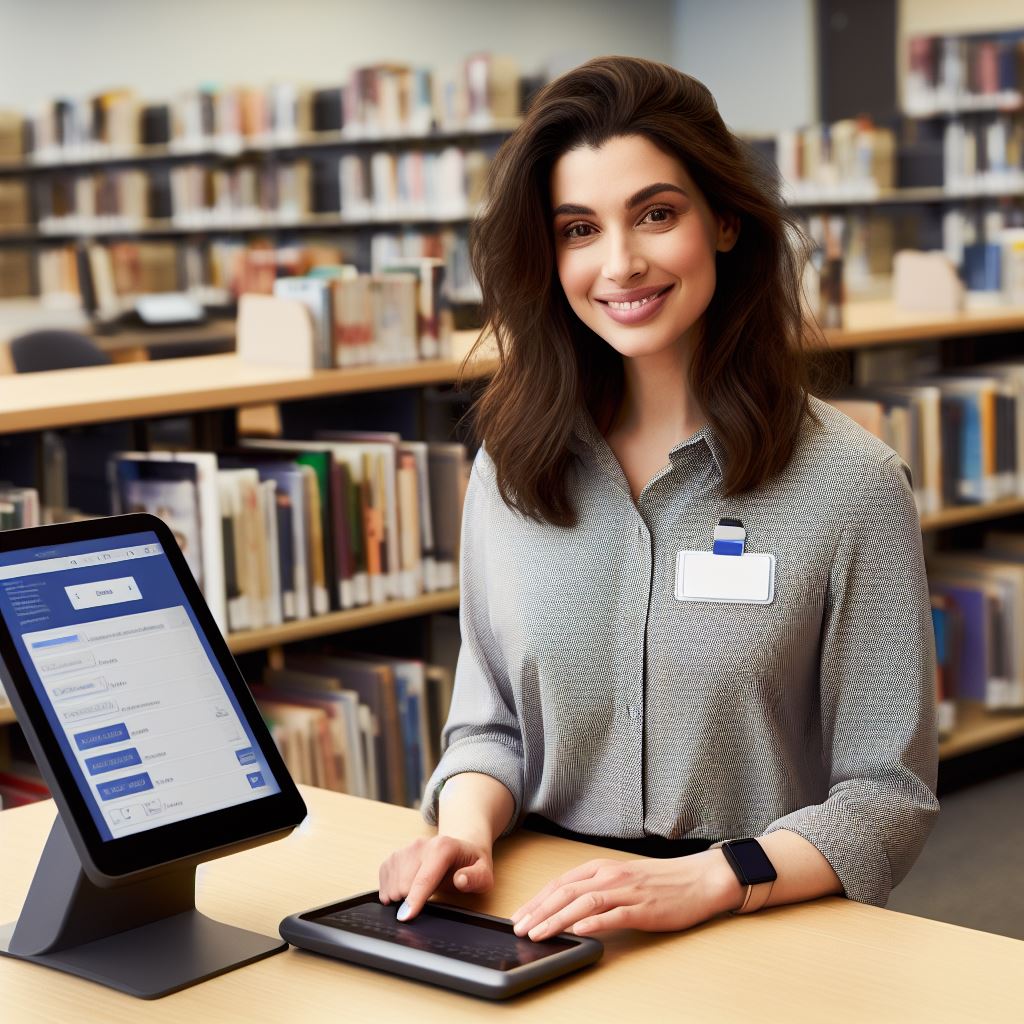Introduction
A digital library is a collection of digital resources that are accessible remotely via computer networks.
Databases, on the other hand, are organized collections of data stored in a computer system.
Librarians play a crucial role in managing digital libraries and databases.
They are responsible for organizing, cataloging, and curating the vast amount of information available on these platforms.
US librarians have been at the forefront of developing and promoting digital libraries and databases.
They have been pioneers in adopting new technologies and implementing innovative approaches to ensure easy access and retrieval of information.
Evolution of Digital Libraries and Databases
Historical background of digital libraries and databases
- The concept of digital libraries and databases emerged in the late 20th century.
- Libraries began digitizing their collections to make information more accessible.
- The first digital libraries focused on text-based materials, such as books and articles.
- Databases were developed to store and manage large amounts of digital information.
- The development of the internet further facilitated the growth of digital libraries and databases.
- Library consortia played a crucial role in sharing resources and expanding digital collections.
- Early digital libraries faced challenges in terms of copyright and preservation of digital materials.
Advancements in technology that led to their development
- The invention of computers and storage devices made it possible to digitize information.
- Improved data compression and encoding techniques reduced the size of digital files.
- Search algorithms and indexing methods improved the searchability of digital collections.
- Networking technologies allow for remote access to digital libraries and databases.
- Advancements in web technologies enabled the creation of user-friendly interfaces.
- Cloud computing and virtualization revolutionized the scalability and accessibility of digital libraries.
Types of digital libraries and databases available today
- Academic libraries digitize scholarly resources, providing access to research articles and journals.
- Public libraries offer e-books, audiobooks, and online databases for public use.
- National libraries preserve cultural heritage through digitized manuscripts and archival materials.
- Special libraries focus on specific subjects like law, medicine, or corporate information.
- Digital repositories store and provide access to research data, software, and multimedia content.
- Open access repositories promote free and unrestricted access to scholarly publications.
- Subject-based databases curate specialized content for researchers in specific fields.
Overall, digital libraries and databases have revolutionized the way information is accessed, stored, and shared.
Advancing technology will shape these platforms, making information more accessible and empowering librarians to lead in digital innovation.
Read: Advocacy and the Librarian: Pushing Boundaries in the US
Key Responsibilities of US Librarians
Collection development and management
US librarians play a vital role in the development and management of digital libraries and databases.
Their primary responsibility is to curate a comprehensive collection of digital resources that meet the needs and interests of their users.
Metadata creation and organization
Librarians are also responsible for creating and organizing metadata, which is essential for efficient information retrieval.
Metadata helps in categorizing and describing digital assets, making it easier for users to locate and access relevant information.
Information retrieval and user support
Librarians are experts in information retrieval systems and play a crucial role in helping users navigate and search through digital libraries and databases effectively.
They assist users in finding the information they need and provide guidance on using various search tools and techniques.
Preservation and maintenance of digital assets
One of the key responsibilities of librarians is the preservation and maintenance of digital assets.
They ensure that the digital resources are properly stored, organized, and protected from any potential risks such as data loss or corruption.
Collaborating with IT professionals and database vendors
- Librarians work closely with IT professionals and database vendors to ensure the smooth functioning of digital libraries and databases.
- They collaborate to address any technical issues, implement necessary upgrades, and ensure that the systems meet the evolving needs of users.
In fact, US librarians lead in managing and ensuring efficient accessibility of digital resources in libraries and databases.
Librarians’ expertise in collection development, metadata, and collaboration with IT professionals is invaluable for meeting digital age information needs.
Read: Librarians’ Role in US Community Development and Outreach
Transform Your Career Today
Unlock a personalized career strategy that drives real results. Get tailored advice and a roadmap designed just for you.
Start NowChallenges Faced by US Librarians in Digital Libraries and Databases
Copyright and intellectual property issues
- Dealing with copyright infringements and ensuring adherence to intellectual property rights.
- Implementing policies and guidelines to protect digital content from unauthorized use.
- Collaborating with legal experts to navigate complex copyright laws in the digital age.
- Addressing fair use and licensing concerns to provide access to copyrighted materials.
Ensuring data integrity and security
- Implementing robust security measures to protect digital collections from cyberattacks.
- Establishing backup systems and disaster recovery plans to ensure data integrity.
- Monitoring and detecting potential breaches to safeguard sensitive user information.
- Updating security protocols regularly to stay ahead of evolving cyber threats.
Managing large volumes of digital content
- Developing effective strategies for organizing and cataloging vast amounts of digital materials.
- Applying metadata standards to enhance the discoverability and accessibility of digital collections.
- Implementing efficient search algorithms to enable quick and accurate information retrieval.
- Creating user-friendly interfaces to navigate and browse extensive digital repositories.
Technological infrastructure and funding limitations
- Securing adequate funding to support the acquisition and maintenance of digital library resources.
- Upgrading technological infrastructure to handle the storage and processing needs of digital collections.
- Investing in skilled IT professionals to manage and troubleshoot complex digital systems.
- Exploring partnerships and collaborations to overcome financial constraints and resource limitations.
In short, US librarians spearheading digital libraries and databases face significant challenges in various aspects.
From navigating copyright and intellectual property issues to ensuring data integrity and security, librarians must remain vigilant.
Additionally, managing large volumes of digital content requires effective organization and searching mechanisms.
Overcoming technological and funding hurdles is crucial for successful digital library implementation.
US librarians persist, adapting to the digital age and preserving valuable knowledge in their collections.
Read: Ethical Guidelines Every US School Counselor Follows

Innovations and Trends
Integration of artificial intelligence in digital libraries
Digital libraries are rapidly embracing artificial intelligence (AI) technology to enhance their services.
AI algorithms can efficiently analyze and categorize large volumes of digital content, making it easier for users to find relevant information.
Through machine learning, AI can also improve search accuracy and recommend personalized content based on user preferences.
Chatbots and virtual assistants powered by AI are being used to provide quick and efficient customer support, answering user queries in real-time.
Further advancements in AI, such as natural language processing, can enable digital libraries to understand and respond to user requests even more effectively.
Use of data analytics for better user experiences
Digital libraries are leveraging data analytics to gain insights into user behavior and preferences.
Through analyzing user data, libraries can identify popular content, predict trends, and optimize their collection to meet users’ needs.
Data analytics also helps librarians identify gaps in their collection and acquisition strategies, enabling them to make informed decisions.
Libraries can use data to personalize user experiences, offering personalized recommendations and tailored content based on individual preferences.
Data analytics can provide valuable feedback on the usability and effectiveness of library interfaces, leading to improvements in user interface design.
Open access initiatives and increased collaboration
Libraries are actively promoting open access initiatives, making scholarly and research resources freely available to the public.
Open access initiatives increase the accessibility and visibility of knowledge, supporting knowledge dissemination and advancement.
Libraries are partnering with academic institutions, publishers, and researchers to expand open access repositories and foster collaboration.
Through collaboration, libraries can pool resources, share expertise, and collectively provide a broader range of digital resources and services.
Transform Your Career Today
Unlock a personalized career strategy that drives real results. Get tailored advice and a roadmap designed just for you.
Start NowOpen access initiatives also encourage the use of creative commons licenses, ensuring proper attribution and fostering a culture of sharing and collaboration.
Mobile and remote access to digital resources
- To cater to modern users’ mobile lifestyles, libraries are offering mobile and remote access to their digital resources.
- Users can now access digital libraries through mobile apps, enabling convenient access to digital materials anytime, anywhere.
- Remote access capabilities allow users to access digital resources even when they are not physically present at the library.
- This flexibility benefits students, researchers, and individuals who require access to resources beyond traditional library opening hours.
In essence, digital libraries are constantly innovating to meet the evolving needs of users.
AI integration, data analytics, open access promotion, and mobile access drive key trends in US digital library development.
These advancements ensure better user experiences, increased collaboration, and wider accessibility to valuable digital resources.
Best Practices for US Librarians in Digital Libraries and Databases
Continuous professional development and staying updated on new technologies
- Librarians in the US should engage in continuous professional development to keep up with the ever-evolving digital technologies.
- This includes attending conferences, workshops, and webinars that focus on digital libraries and databases.
- Staying updated on new technologies is crucial for librarians to effectively manage and curate digital collections.
Building strong partnerships with database vendors and information technology experts
Collaboration is key for librarians to successfully navigate the digital landscape.
Building partnerships with database vendors and IT experts, librarians gain valuable insights for managing digital libraries effectively.
These partnerships can lead to better access to resources, customized services, and technical support.
User-centric approach in designing and improving digital services
Librarians should always prioritize the needs of their users when designing and improving digital services.
This user-centric approach ensures that digital libraries and databases are user-friendly, intuitive, and accessible.
Conducting user research, collecting feedback, and incorporating user suggestions are essential practices for creating an optimal user experience.
Promoting information literacy skills among users
- Information literacy is a crucial skill in the digital age. Librarians should take an active role in promoting information literacy skills among users.
- This involves guiding credibility evaluation, teaching search strategies, and promoting critical thinking when consuming digital content.
- By empowering users with information literacy skills, librarians contribute to a more informed and digitally literate society.
Basically, US librarians can adopt several best practices to excel in managing digital libraries and databases.
Continuous professional development ensures that librarians stay updated on new technologies and trends.
Building strong partnerships with database vendors and technology experts fosters collaboration and access to valuable resources.
A user-centric approach in designing and improving digital services enhances the user experience.
Lastly, promoting information literacy skills among users contributes to a more informed society.
By embracing these best practices, US librarians can remain at the forefront of digital libraries and databases.
Read: Technology’s Role in Modern School Counseling Practices
Conclusion
In this blog section, we have explored the crucial role played by US librarians in the development and advancement of digital libraries and databases.
They have been at the forefront of this field, utilizing their expertise to transform the way information is accessed and shared.
US librarians should seize the opportunities presented by digital libraries and databases to enhance their profession.
Transform Your Career Today
Unlock a personalized career strategy that drives real results. Get tailored advice and a roadmap designed just for you.
Start NowBy adapting to emerging technologies, they can expand their reach, provide better services, and meet the changing needs of library patrons in the digital age.
The future of digital libraries and databases is promising, with continued innovation and advancements in technology.
US librarians will continue to play a crucial role in shaping this future, ensuring equitable access to information, and preserving our cultural heritage.
Embracing the digital revolution, US librarians can create inclusive and collaborative platforms, promoting lifelong learning and fostering a sense of community.
The challenges posed by the rapid growth of digital resources can be met with adaptability, creativity, and a commitment to serving the needs of diverse library users.
In closing, US librarians are at the forefront of digital libraries and databases, driving innovation and ensuring access to information in the digital age.
Librarians play a vital role in shaping the future of inclusive, technologically advanced libraries, empowering individuals in their pursuit of knowledge and growth.




